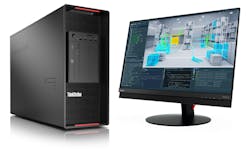Workstations are key tools for most engineering and software development groups. Regular PCs and laptops have continued to grow in terms of performance, but they usually fall short of what most people call a workstation. This might be because of what CPUs and GPUs are utilized, or how much memory and storage might be available. Workstation applications tend to be more demanding in all of these areas.
A good example of the changes in workstation performance and capabilities is Lenovo’s AI Workstation (see figure). The ThinkStation P920 sports a pair of Intel Xeon Gold 6136 processors and two NVIDIA RTX 6000 connected via NVLink communications connections and AI-optimized Tensor cores. It comes with 384 GB of 2666-MHz DDR4 memory with ECC support. It boots from a 1-TB M.2 NVMe SSD and there are two 2-TB, 2.5-in. SATA SSDs for data storage. Ubuntu Linux is installed on the SSDs. This NVIDIA RAPIDS-ready platform can support AI frameworks like TensorFlow, Caffe, and PyTorch.
Lenovo’s AI Workstation combines Intel Xeons and NVIDIA’s Quadro RTX 6000 to deliver high-performance computational capabilities.
But what do you think should be in a workstation?
Jon Peddie Research is doing a short workstation survey. I added my two cents, and I’ll be checking out the results of the survey when it’s complete. It asks more questions than what I noted here, such as what king of operating system and features are important in your viewpoint in a workstation.
I will have an article covering the results when the survey is complete, so check it out.





